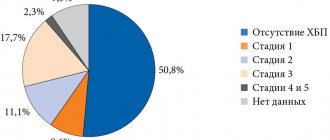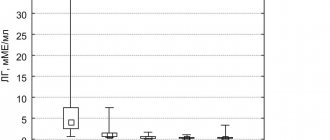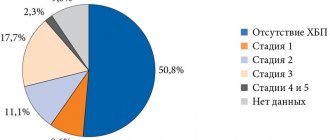Diabetes mellitus (DM) is an acute medical and social problem that is one of the priorities of the national health care systems of almost all countries of the world.
The first attempts to treat diabetes with oral medications date back to 1926, when Frank, Nothmann and Wagner synthesized and clinically used one of the diguanidine derivatives, synthalin [1].
For several years the drug was used in Germany to treat patients with diabetes, but due to its pronounced hepatotoxic effect it was banned.
In 1959, dimethyl biguanide, metformin, began to be used for the first time. Since the mid-1950s. biguanides began to be widely used in the 1960–1970s. Phenformin and buformin entered medical practice, but their significant drawback was soon noted - the development of lactic acidosis. In 1977, phenformin was banned for clinical use in the USA, Canada and several other countries. In our country it was practically not used.
Glucophage is the original drug of metformin [2]. It has been used as an antihyperglycemic drug for the treatment of type 2 diabetes (T2DM) for more than 50 years. In contrast to sulfonylurea derivatives, which stimulate insulin secretion, Glucophage enhances its effect on peripheral tissues, reducing insulin resistance (mainly in the liver and muscle peripheral tissues) to the action of insulin. The mechanism of action of Glucophage is antihyperglycemic, not hypoglycemic, since the level of glucose in the blood decreases only in cases where it was initially elevated.
Metformin increases glucose uptake into muscle and adipose tissue by enhancing insulin binding to receptors and increasing the activity of the glucose transporters GLUT-1 and GLUT-4. It reduces the production of glucose by the liver, reduces glycogenolysis and absorption of glucose in the intestine, enhances its utilization, and reduces appetite. In addition, Glucophage improves clinical indicators in patients with both prediabetic conditions (Diabetes Prevention Program) [3] and established T2DM (UK Prospective Diabetes Study) [4]. There is evidence that Glucophage can help reduce the severity of diabetic complications [4].
In recent years, some authors have noted a deterioration in tissue sensitivity to insulin in patients with type 1 diabetes (T1DM). A number of studies indicate the presence of insulin resistance in patients with slowly progressive type 1 diabetes (LADA) [5]. It is noted that with LADA it is higher than with newly diagnosed T1DM, but less than with T2DM. Currently, there are no specific treatment algorithms for patients with LADA. However, many researchers do not recommend sulfonylurea drugs to such patients, since by stimulating insulin secretion in conditions of an autoimmune process, they contribute to its rapid depletion. Taking into account the presence of insulin resistance in LADA, it is considered advisable to use drugs aimed at overcoming it, primarily metformin, which can significantly expand the possibilities of its use [6, 7].
A significant limitation regarding the use of metformin are adverse events (AEs) from the gastrointestinal tract (GIT), which can be observed, according to various authors, in approximately 20% of patients, mainly when initiating therapy [8]. These AEs often disappear with continued use of the drug, as well as with a reduction in its dose. However, it is estimated that 5% of patients completely stop taking metformin due to gastrointestinal AEs. It should also be noted that the pharmacokinetic parameters of metformin make it necessary to take the drug 2-3 times a day. For some patients, this presents certain difficulties, because they are taking several other medications for concomitant diseases. Low compliance with polypharmacy is accompanied by increased mortality [9].
The use of an innovative long-acting form of metformin, Glucophage Long (Glucophage XR in Europe and the USA), may help optimize treatment among many patients receiving a traditional dosage form.
Absorption of standard metformin occurs over a limited area of the upper gastrointestinal tract and is practically absent in its lower parts. The degree of absorption of metformin from the gastrointestinal tract depends on the rate of its evacuation from the stomach.
A new long-acting dosage form of metformin, Glucophage Long, was created using the GelShield diffusion system technology, a feature of which is the presence of a double gel hydrophilic matrix. The outer dense amorphous polymer, which does not contain metformin, surrounds the granules of the inner polymer containing metformin located within it [10].
The unique diffusion system through the GelShield gel barrier provides controlled, sustained release of metformin from the tablet and delayed passage of the tablet itself through the gastrointestinal tract. When swallowed, the Glucophage Long tablet swells and turns into a gel-like mass. Released from the internal polymer, metformin diffuses through the external polymer matrix, entering the gastrointestinal tract for absorption. If, when using the standard form, 90% of metformin is released within 30 minutes, then when treated with Glucophage Long, a similar proportion is released within 10 hours. The rate of release of metformin into the gastrointestinal tract is independent of the severity of peristalsis or changes in pH, which helps to minimize the variability in drug release both within one patient and within the population.
The high efficacy and better tolerability of Glucophage Long have been confirmed in a number of clinical studies involving a large number of patients with T2DM.
The purpose of a double-blind study conducted by S. Schwartz et al. [11], studied the efficacy, tolerability and safety of a new oral extended-release formulation of metformin (Glucophage Long) compared with regular-release metformin when administered to patients with T2DM for 24 weeks.
Adult patients with T2DM (newly diagnosed; receiving non-drug treatment or therapy with oral hypoglycemic drugs) were randomized to one of three long-acting metformin treatment regimens (Glucophage Long 1500 mg/day in 1 dose, 1500 mg/day in 2 doses, 2000 mg/day in 2 doses) or standard metformin (1500 mg/day in 2 doses).
In all groups after 12 weeks, a statistically significant (p < 0.001) decrease in the average HbA1c level was noted. Moreover, in two groups receiving Glucophage Long at 1500 mg/day, the average decrease in HbA1c concentration (-0.73 and -0.74%) did not differ significantly from that in the standard metformin group (-0.70%), while that in patients receiving long-acting metformin therapy at a dose of 2000 mg/day, a more pronounced decrease in HbA1c levels was observed (-1.06%). The rapid decline in fasting plasma glucose levels began in the first week, continued until the eighth week, and was then maintained at this level until the end of the study. Overall, the incidence of AEs was similar in all groups, but fewer patients discontinued treatment early due to initial nausea in the extended-release metformin groups than in the immediate-release metformin group. Thus, therapy with extended-release metformin Glucophage Long 1 or 2 times a day was as safe and effective as therapy with standard metformin 2 times a day, providing a decrease in glycemic levels over 24 weeks of treatment.
K. Fujioka et al. conducted two double-blind randomized clinical trials studying the long-acting metformin Glucophage Long compared with placebo [12]. In one study, 240 patients with T2DM decompensated by diet and exercise were randomized 2:1 to receive long-acting metformin 1000 mg or placebo once daily. For patients with HbA1c levels ≥ 7% and < 8% after 12 weeks of therapy, extended-release metformin (total daily dose of 1500 mg) was prescribed for an additional 12 weeks. The second study was conducted to determine the optimal dose of extended-release metformin Glucophage Long, and included 742 patients with T2DM, decompensated by diet, randomized to placebo or extended-release metformin at doses of 500, 1000, 1500 or 2000 mg once a day or 1000 mg 2 times a day for 16 weeks.
The incidence of diarrhea or nausea/vomiting in these two studies was approximately 50% lower than in another 14-week placebo-controlled study (n = 451) conducted to determine the optimal dose of immediate-release metformin for patients with T2DM. decompensated due to diet [13]. The proportion of patients who prematurely discontinued participation in the study due to gastrointestinal AEs during therapy with Glucophage Long was significantly lower than when using standard metformin (1.8 versus 5.9%). When studying various dosages of extended-release metformin, the dose-dependence of the effects of this form of the drug when taken once a day was shown, with the maximum effect being achieved when using doses of 1500 and 2000 mg/day.
The dynamics of the decrease in HbA1c levels in the group of patients receiving extended-release metformin 1000 mg twice a day (-1.2%) was similar to that in the group of patients receiving 2000 mg of the drug at a time (-1.0%). There was no decrease in efficacy when switching a patient from standard metformin to its extended-release form.
The results obtained confirm the data according to which the glucose-lowering effect of long-acting metformin Glucophage Long when taken once a day is comparable to that of standard metformin prescribed in several doses throughout the day. No clear dose-response relationship has been established for the occurrence of gastrointestinal adverse events when administered extended-release metformin in doses of 1000 to 2000 mg [14].
Subsequently, K. Fujioka et al. conducted a double-blind, randomized study that examined the effectiveness of switching patients with T2DM from conventional metformin to long-acting metformin therapy [15]. Patients received standard metformin 500 mg twice daily for a two-week run-in period, and then 217 were randomized to continue therapy with this drug or switch to the extended-release metformin Glucophage Long at a dose of 1000–1500 mg once daily. The objectives of this study were not to compare drug tolerability, but it was shown that with the use of extended-release metformin, the incidence of gastrointestinal AEs was 10% lower compared to taking a similar dose of standard metformin.
Glucophage Long is available in tablets of 500 and 750 mg, in packs of 30 or 60 pieces. It is recommended to start taking Glucophage Long with one tablet of 500 mg per day, gradually increase the dose to 2 tablets of 750 mg per day with an evening meal. Maximum dosage: 4 tablets of 500 mg or 3 tablets of 750 mg once.
Thus, better tolerability of extended-release metformin is ensured by the original tablet structure. The absorption of metformin from the extended-release tablet (Glucophage Long) is slower and longer than the conventional form, which avoids the occurrence of gastrointestinal adverse events, ensures better tolerability of the drug and helps to increase the adherence of patients with T2DM to metformin therapy.
Contraindications and complications
Since Glucophage is a medication, like any drug, it has a number of contraindications:
- individual intolerance,
- with alcohol abuse (the drug is not compatible with alcohol),
- during pregnancy and lactation,
- in case of disruption of the gastrointestinal tract,
- for kidney diseases.
But even in the absence of contraindications, cases of the following complications developing are not uncommon:
- muscle pain,
- fatigue and weakness,
- stool disorder,
- stomach pain,
- bloating,
- shortness of breath,
- dizziness,
- vomit,
- nausea,
- metallic taste in the mouth,
- in especially severe cases, confusion is noted.
In order to avoid the development of side effects, the medication should be used as directed and the instructions for use should be followed.
Glucophage long 750 for weight loss
Glucophage Long 750 for weight loss is often used due to the effectiveness of weight loss, while it has a low cost and can be purchased without a prescription. On the Internet you can find a large number of positive reviews related to weight loss. But it is worth noting that the risk of complications is high, so you should consult your doctor before use.
Read also: Kalentyeva took 6th place at the Mountain Bike World Cup stage
How to use glucophage for weight loss ? The daily dosage should not exceed 2000 mg; one tablet should be taken daily for three weeks; if there is no result, the dosage is increased to 2-3 tablets per day.
How to take Glucophage for weight loss
Recently, Glucophage Long has been increasingly used for weight loss. The drug has a prolonged and complex effect, which differs from the classic form. Since absorption of the main substance occurs over a long period of time, it is recommended to use the drug once a day. Glucophage is taken only with meals, with a small amount of water. If used on an empty stomach, the risk of stomach problems and other side effects increases.
Read also: Holidays in the mountains: getting ready for the trip
Glucophage is also available in different dosages, namely 500, 750, 850 and 1000 mg. The latter type has a high dosage of the active substance, and its use is permitted only as prescribed by a doctor. It is worth remembering that the daily dose of the drug should not exceed more than 2000 mg.
How to take Glucophage Long 750 for weight loss
In order to achieve results, the drug must be taken correctly, following some recommendations.
Glucophage long 750 instructions for weight loss:
- The course of treatment should not exceed more than three weeks.
- After completing the course, you should take a break for at least one month.
- It is strictly forbidden to combine Glucophage 750 with antipsychotics and diuretics.
- If symptoms of intoxication appear, namely, deterioration of health, development of nausea or vomiting, the dosage should be reduced by half or completely discontinued.
- Even if there are no results, it is forbidden to exceed the dosage of more than 2-3 tablets per day, which is fraught with the development of complications.
- During use, you should avoid any physical activity, as it can provoke the development of various negative conditions.
- Avoid smoking and drinking alcoholic beverages.
- The diet should be rich in protein products - eggs, fish, lean meats, as well as cereals - buckwheat, oatmeal. Products containing sweeteners and fructose, as well as honey, are also allowed in small quantities.
- It is very important to eat a low-carbohydrate diet, avoiding sweet fruits, sugar, baked goods and confectionery. If the rule is not followed, bloating and stool disturbance often develop. Reduce consumption of pasta, rice, potatoes.
When taking Glucophage Long 750 for weight loss, the instructions must be followed strictly, this is the only way to avoid the toxic effects of the medication on the body.






